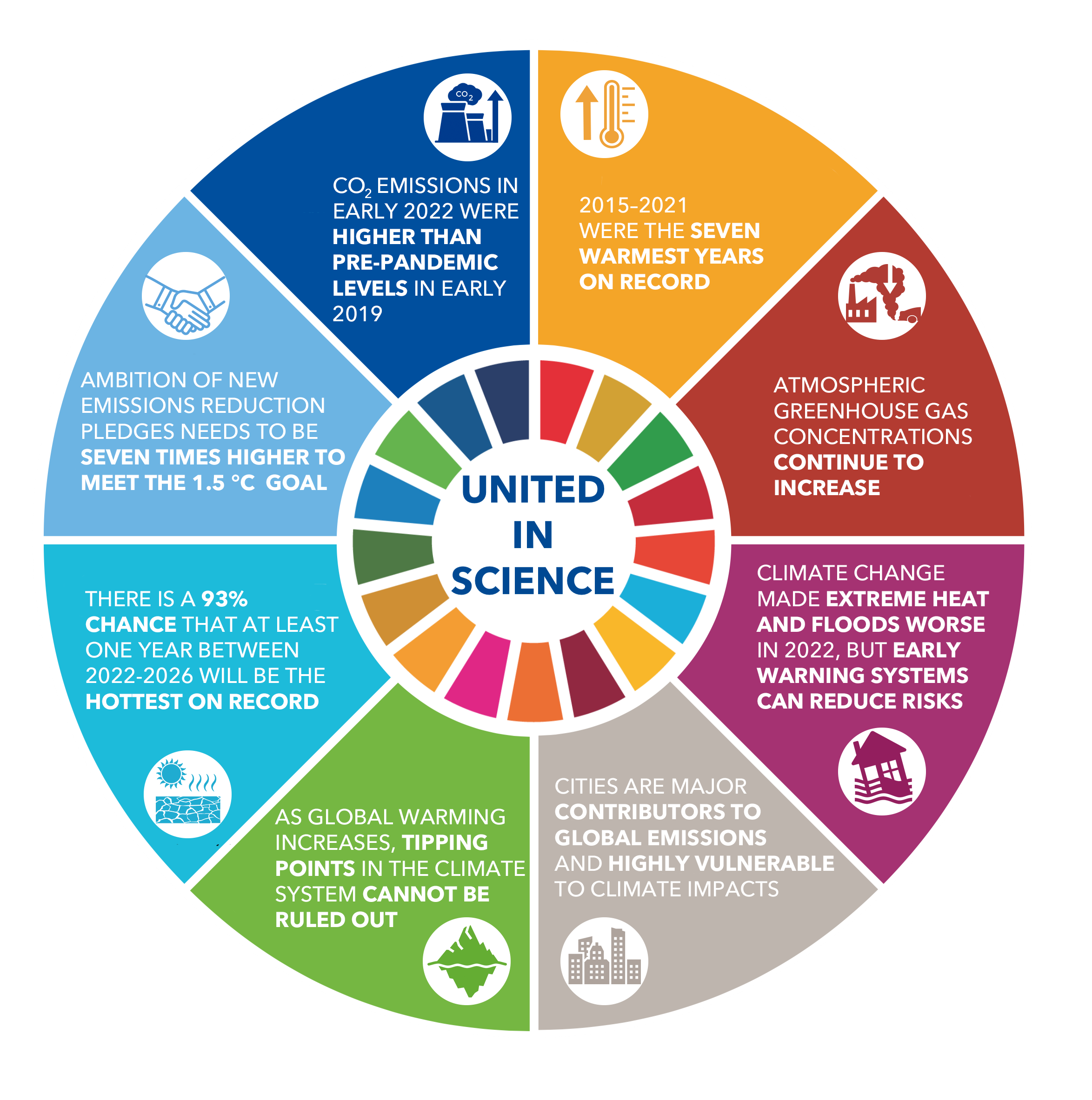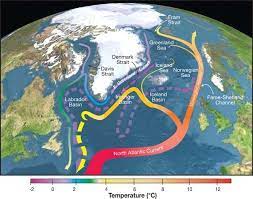Article Title: World in ‘wrong direction’ as climate impacts worsen: UN
14-09-2022
Environment & Ecology Current Affairs Analysis
World in ‘wrong direction’ as climate impacts worsen: UN
What’s in News?
Recently, the World Meteorological Organization (WMO) have released “United in Science” Report 2022, titled: “United in Science: We are heading in the wrong direction”
United in Science Report:
This report has been compiled by the World Meteorological Organization (WMO) under the direction of the United Nations Secretary-General to bring together the latest climate science-related updates from key global partner organizations – WMO, Global Carbon Project (GCP), UN Environment Programme (UNEP), Met Office (United Kingdom), Urban Climate Change Research Network (UCCRN), UN Office for Disaster Risk Reduction (UNDRR), World Climate Research Programme (WCRP, jointly sponsored by WMO, IOC-UNESCO and the International Science Council (ISC)) and the Intergovernmental Panel on Climate Change (IPCC).
Key Highlights of the Report:
(i) Greenhouse Gas (GHG) Concentrations in the Atmosphere
Levels of atmospheric carbon dioxide (CO2), methane (CH4) and nitrous oxide (N2O) continue to rise.
The temporary reduction in CO2 emissions in 2020 during the pandemic had little impact on the growth of atmospheric concentrations
(ii) Global Greenhouse Gas Emissions and Budgets
Global fossil CO2 emissions in 2021 returned to the pre-pandemic levels of 2019 after falling by 5.4% in 2020 due to widespread lockdowns.
Global CO2 emissions in 2022 (January to May) are 1.2% above the levels recorded during the same period in 2019, driven by increases in the United States, India and most European countries.
Despite a strong fluctuation in global emissions over the past two and a half years, fossil CO2 emissions fell significantly in 23 countries (many European countries, Japan, Mexico and the USA) during the pre-pandemic decade of 2010–2019.
A quarter of GHG emissions from land-use change are associated with the trade of food between countries, of which more than three quarters are due to land clearing for agriculture, including grazing.
(iii) State of the Global Climate: 2018–2022
The most recent seven years, 2015 to 2021 were the warmest on record.
The 2018–2022 global mean temperature average (based on data up to May or June 2022) is estimated to be 1.17 ± 0.13 °C above the 1850–1900 average.
A La Niña event has had a slight cooling effect on temperatures in 2021/22 but this will be temporary
Around 90% of the accumulated heat in the Earth system is stored in the ocean, the Ocean Heat Content for 2018–2022 was higher than in any other 5-year period, with ocean warming rates showing a particularly strong increase in the past two decades.
(iv) Global Climate Predictions for 2022–2026
The annual mean global near-surface temperature for each year from 2022-2026 is predicted to be between 1.1 °C and 1.7 °C higher than pre-industrial levels (1850-1900).
The likelihood of the annual mean global near-surface temperature temporarily exceeding 1.5 °C above pre-industrial levels for at least one of the next five years is 48% and is increasing with time.
The Paris Agreement level of 1.5 °C refers to long-term warming, but individual years above 1.5 °C are expected to occur with increasing regularity as global temperatures approach this long-term threshold
There is a 93% probability that at least one year in the next five will be warmer than the warmest year on record, 2016, and that the mean temperature for 2022–2026 will be higher than that of the last five years
(v) Emissions Gap
Enhanced mitigation action is needed to prevent the goals of the Paris Agreement from slipping out of reach
New national mitigation pledges for 2030 show some progress toward lowering greenhouse gas emissions, but are insufficient.
The ambition of these new pledges would need to be four times higher to get on track to limit warming to 2 °C and seven times higher to get on track to 1.5 °C.
(vi) Tipping Points in the Climate System
The Atlantic Meridional Overturning Circulation (AMOC) is an important driver of the distribution of heat, salt and water in the climate system, both regionally and globally.
Recent research suggests AMOC may be weaker in the current climate than at any other time in the last millennium.
The melting of the polar ice sheets on Greenland and Antarctica is also considered a major tipping point and would have global consequences due to substantial additional sea-level rise for hundreds to thousands of years.
Regional tipping points, such as the drying of the Amazon rainforest may have serious local consequences with cascading global impacts.
Other examples include regional droughts which impact the global carbon cycle and disrupt major weather systems such as monsoons.
The combined effects of higher temperatures and humidity in some regions could reach dangerous levels in the next few decades, with physiological tipping points or thresholds beyond which outdoor human labor is no longer possible without technical assistance.
(vii) Climate Change and Cities
Cities – home to 55% of the global population, or 4.2 billion people – are responsible for up to 70% of human-caused emissions while also highly vulnerable to the impacts of climate change such as increased heavy precipitation, accelerated sea-level rise, acute and chronic coastal flooding and extreme heat, among other key risks.
Globally, by the 2050s, over 1.6 billion people living in over 970 cities will be regularly exposed to 3-month average temperatures reaching at least 35 °C (95 °F).
Between March and May 2022, Delhi experienced five heat waves with record-breaking temperatures reaching up to 49.2 °C (120.5 °F).
With half of Delhi’s population living in low-income settlements and highly vulnerable to extreme heat, this heatwave led to devastating socioeconomic and public health impacts.
Low-lying coastal cities and settlements, such as Bangkok (Thailand), Houston (USA) and Venice (Italy), are highly likely to face more frequent and more extensive coastal flooding due to sea-level rise, storm surges and subsidence.
(viii) Extreme Weather Events and Socioeconomic Impacts
The number of weather, climate and water-related disasters has increased by a factor of five over the past 50 years, causing US$ 202 million in losses daily.
The World Weather Attribution initiative found that climate change likely increased the intensity of the rainfall experienced due to these storms.
As the atmosphere becomes warmer, it holds more water, which, on average, makes wet seasons and events wetter.
With further emissions and rising temperatures, heavy rainfall episodes will become more common.
Summer heatwaves pose a significant risk to human health, especially the elderly and infirm.
Other factors – such as socioeconomic conditions, urbanization (the urban heat island) and levels of preparedness – can also increase vulnerability.
Recommendations:
Early warning systems save lives, reduce losses and damages, contribute to disaster risk reduction and support climate change adaptation
Less than half of all countries in the world have reported the existence of Multi-Hazard Early Warning Systems (MHEWS), with coverage particularly low in Africa, Least Developed Countries and Small Island Developing States
Ensuring everyone on Earth is protected by MHEWS will require collaboration across diverse actors and innovative financing solutions.
Way Forward:
Now is the time to integrate adaptation and mitigation, coupled with sustainable development, into the ever-dynamic urban environment.
Atlantic Meridional Overturning Circulation (AMOC):
The AMOC is a large system of ocean currents.
It is the Atlantic branch of the ocean conveyor belt or Thermohaline circulation (THC), and distributes heat and nutrients throughout the world’s ocean basins.
AMOC carries warm surface waters from the tropics towards the Northern Hemisphere, where it cools and sinks.
It then returns to the tropics and then to the South Atlantic as a bottom current.
From there it is distributed to all ocean basins via the Antarctic circumpolar current.
A weaker AMOC will bring less warm water northwards, and this will partly offset the warming effect of the greenhouse gases over western Europe.
World Meteorological Organization (WMO):
WMO is a specialized agency of the United Nations (UN) with 193 Member States and Territories.
WMO originated from the International Meteorological Organization (IMO), which was founded in 1873 to facilitate the exchange of weather information across national borders.
Established in 1950, the WMO became a specialized agency of the United Nations in 1951.
Its mandate is in the areas of meteorology (weather and climate), operational hydrology and related geophysical sciences.
It’s headquarters is located in Geneva, Switzerland


 "UPSC-2026-PRELIMS COMBINED MAINS FOUNDATION PROGRAMME" STARTS WITH ORIENTATION ON FEB-10
"UPSC-2026-PRELIMS COMBINED MAINS FOUNDATION PROGRAMME" STARTS WITH ORIENTATION ON FEB-10